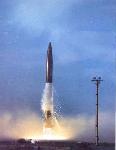





Following an intensified and apparently successful testing of the DF-2 MRBM in 1966, little activity was observed by US intelligence relating to this system from the fall of 1966 through early 1969. During that time there were occasional exercises and possible indications of a few firings but no firm evidence of troop training. At the Wuvei missile school, no equipment was observed and some type of construction which had begun in 1956 continued at a very slow pace through at least 1969. A few firings from October 1966 through mid-1968 were probably associated with missile modifications. It appeared that the Chinese had no intentions at that time of deploying the DF-2, although it was within their capability,and were beginning to concentrate their resources on developing an IRBM.
However, deteriorating border relations with the Soviets in 1968 may have caused the Chinese to rethink their missile strategy for deploying the DF-2. In August 1968, the lull was broken with the appearance of possible DF-2 troop training exercises at the Shuangchengtzu Launch Complex A. On several occasions during the remainder of the year, support equipment was visible at the launch complex. There were 14 confirmed crew-training firings through early 1972.
The picture began to change in 1969-1970, as evidence accumulated of renewed DF-2 activity. It appeared reasonably certain that troop training, involving live firings from Shuangchengtzu, and possibly classroom and missile handling instruction at Wuwei, was underway at least by the spring of 1969 if not by August 1968.The Chinese began troop training firings of the DF-2 MRBM system at least by the spring of 1969 in preparation for deployment. Around the time the DF-2 achieved initial operational capability (IOC), the Zhenbao/Demansky Island conflict flared up (March 1969) and then spread from the Ussuri River along the border into Central Asia, raising the prospect of a Soviet strike into China. This prospect was supported by a widespread rumor that the USSR was considering a "surgical strike" on the Chinese nuclear testing facilities in Xinjiang.
The DF-2 was transportable (but not tactically mobile), and Chinese photographs indicate that it was deployed in long caravans consisting of the launcher and its support and fueling vehicles. These same photographs show what appear to be an unusually large number of personnel associated with the launch process. The missile is towed on a flatbed launcher to the site. It is then elevated into its firing position through what appears to be a lengthy and complicated process. Quite likely the DF-2 with its multiple fuel trucks was the subject of a Chinese broadcast which applauded a "fueling squadron" for reducing fueling time from 10 to 6 hours for an undesignated missile. Deployment of this system, begun in 1969-70, appears to have stabilized at about 50 weapons in the mid 1970s. Production of the DF-2A ceased at the beginning of 1970. The DF-2 was removed from the inventory of the Chinese People's Liberation Army (CPLA) in 1979 and replaced with the more modern DF-3 and DF-21 systems.
Specifications |
|
| First Test | 1963 |
| Firings as of 1972 | 35-40 |
| IOC | 1966-1970 |
| Range (km) | 1,250 |
| Re-entry Vehicle Mass (kg) | 1,500 |
| Warhead Yield | 12 KT or 3 MT |
| CEP (km) | 2-4 |
| Propellant | Cryogenic |
| Deployment | Soft |
| Configuration | Single Stage |
| Length [meters] | 20.6 |
| Diameter [meters] | 1.65 |
| Mass [kilograms] | 32,000 |
| Guidance | Inertial |
| Launch Preparation Time | 150-180 minutes |


